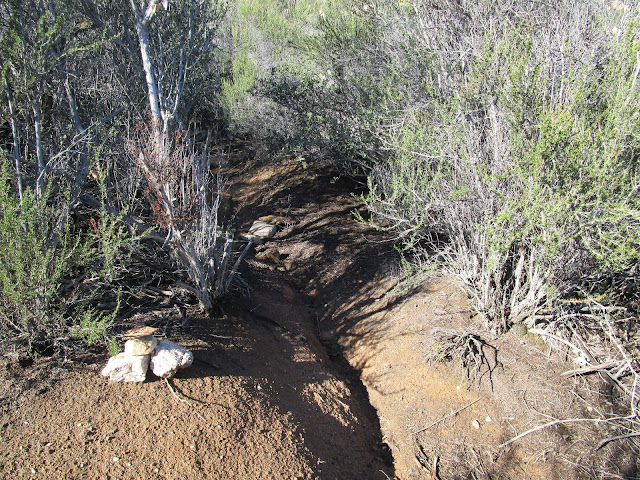Distance: 8.1 miles round trip on road and use trail
Summit Elevation: 3664' (Lawson), 3836' (Gaskill)
Prominence: 420' (Lawson), 1196' (Gaskill)
Elevation Gain: 2575'
Elevation Gain (in Empire State Buildings): 2.06
Round trip time: 4 hours 30 minutes
Recommended water: 96 oz.
Parking/Fees: Free on Japatal Lyons Valley Road
Difficulty: Moderate
Lawson (SDC #56) and Gaskill (SDC #54) had been on my radar a long time. These San Diego peaks have exciting summit blocks and interesting scrambling routes. Since they are in close proximity, they are usually hiked together. To get to the trailhead, take highway 94 east from San Diego, then left on Lyons Valley Road, continue until it turns into Japatal Lyons Valley Road and park at the intersection with (unsigned) Skye Valley Road at mile marker 130. There is room for about 4 cars on the shoulder on the south side of the road. Hike north past a gate up Carveacre Road (Forest Road 16S03).
I got started at sunrise with the temp a nippy 32F. The road was damp and a little muddy in places from rain the day before. Gaskill was the first to come into view, followed by the impressive structure of Lawson. The road climbed then dipped down to the base of Lawson. The use trail was obvious and directly ahead from the road. It went straight up Lawson at first with plenty of class 2/3, then started to work to the right of the summit block. I followed the use trail behind the summit and found an exposed class 3/4 route up (direct route). The 2002 edition of the Jerry Schad book on San Diego County suggests going up a chimney to reach a cave on the way to the summit. I found the chimney a short distance past the direct route. However, some key chock stones in the chimney had fallen making it a difficult, probably class 4 problem. Someone anchored a climbing rope above the second chock stone and the end hung just below it. I tested the rope and it seemed OK. Before deciding how to proceed, I continued past the Schad route, but didn't find another way up. I didn't go completely around the summit, so there might be other options. I went back and looked at the direct route, then decided to try the Schad route because I wanted to see the cave. There were holds to get over the first chock stone, but I had to pull myself up with the rope to get over the second. Without the rope, I would have used the direct route. The rope itself looked to be in pretty good shape, but I'm not sure about the anchor. I am no rope expert, but urge caution using this rope in the future, especially after a few more years of weathering (if it is not removed before then). At the end of the cave, an opening on the left leads to a final class 3 slab to the summit area. I found two reference marks and the benchmark. Reference mark #2 appears to be the high point, about 5' above the benchmark. I did not find a register. I took photos and a short break before descending the way I came up, using an arm rappel to get down. Next up was Gaskill.
Gaskill Peak is not far from Lawson. I found a large cairn on the side of the road marking the south use trail. From satellite recon, the south use trail looked a little vague to me. I chose to go further up the road to the east use trail instead since it was more clearly visible and probably more recently groomed. The last left turn to find the east use trail is marked with a small cairn a few stones high. The trail slices a narrow path through the vegetation, then begins a steep ascent. There are a couple of short dead end branches, so if you get into the brush, you probably got off track. Some scrambling is required to get to the base of the summit, with several good route choices. I followed the use trail around the south side of the base and found a large enclosed area, similar but wider than the cave on Lawson. That led to a final class 3 move to get on top. I didn't see any benchmarks on Gaskill, and the ammo box on the summit was filled with a geocache register and goodies like shaving cream and a razor. The quiet was punctuated by a long series of gunshots in the valley to the north, probably from a gun range. The views were excellent, though the summit is not as impressive as Lawson. On the way back, I spotted a group of hikers about half way up Lawson, the first people I had seen all day. These peaks lived up to their reputation as some of the most fun in San Diego County.






























































